Road Trip to Hampi – The City of Temple Ruins
Hampi is located in central part of the state of Karnataka. Dating back to 1500 AD, it was the capital of the Vijayanagar Dynasty and is believed to have been the second largest city of the world at that time. Declared as UNESCO World Heritage site, the temples of Hampi are an exemplary example of workmanship and reflect the splendor of the erstwhile Vijaynagar Empire. The city had a population of half a million people and it flourished because of its control over the cotton and spice trade routes of Southern India. However; the glory of Vijaynagar was short lived. The combined armies of the five Mughal kingdoms – Bidar, Bijapur, Golconda, Ahmednagar and Berar, destroyed this mighty empire in 1565.
Plan:
Located at the banks of Tungabhadra river, Hampi is spread in an area of 26 sq. km and consists of about 100 odd attractions. 2-3 days itinerary is required if you plan to cover all of them. However, if you want to cover the major attractions, as in our case, one day is sufficient. You can refer to the following site to check all the places of interest at Hampi – http://hampi.in/
We planned a road trip to the city of temple ruins during October 2016 from Pune and included Bangalore in the trip to meet a few friends and relatives. 4 days itinerary was put together to explore Hampi and visit Bangalore. If you are planning a to-and-fro trip to Hampi from Pune or Bangalore without including any other place, 3 days are sufficient for it.
There are a few things to keep in mind before venturing for a road trip in India and my blog can be referred for a few tips – https://travel-memoirs.com/travel-tips
Suggestion: Close to Hampi, there are a few other major heritage sites dating back to the times of Chalukyas. Bijapur, Badami, Aihole and Pattadakal can be included in your itinerary if you have time. Refer to my below blog which covers trip to these heritage sites during 2018.
https://travel-memoirs.com/road-trip-to-north-karnataka
There are several options to stay in and near Humpi. After reading good online reviews, we booked hotel Malligi in Hosapete for a day. Hosapete is a major town on the way to Hampi and offers several options to stay.
Note: While planning for trips, I take inputs for road conditions from Team BHP and most of my online hotel bookings are done via makemytrip and yatra
Journey:
Our ride was petrol variant sedan – Maruti Swift Dezire with 1197 cc engine. My fellow passengers were my wife and 2 kids. Me and my wife were to take turns to drive
Day 1: Drive from Pune to Hampi (600 km, 10 hrs)
There are two routes to reach Hampi from Pune.
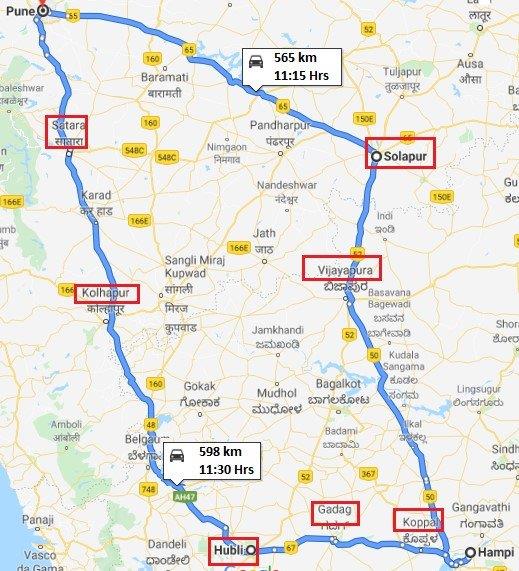
- Solapur – Vijaypura (Bijapur) – Hosapete which is 565 km and google maps estimates 11 hours of journey. Having traveled a couple of times before, I was aware of good road conditions from Pune till Solapur. However, after a couple of average reviews on several blogs for the Solapur – Vijaypura – Hampi route, we decided to give this route a miss, though it was 30 km shorter.
- NH-48 via Pune – Hubli – Gadang – Koppal. This route is 598 km and takes 10 hrs. Pune-Bangalore is an excellent 6 lane expressway till Hubli. Having travelled on this route several times in past, we opted for it.
Keeping in view a long drive of 600 km, we left Pune early at 6 am. We took NH48 (Pune-Bangalore Expressway) and stopped at our regular pit stop at the Vithal Kamat Restaurant (after the Khed-Shivapur Toll plaza) for breakfast. Post breakfast, we were back on the highway and soon bypassed Satara & Kolhapur.
We again stopped at Belgaun for a quick lunch and then continued further on our journey. We touched Hubli by 3 PM, from where we look a left turn to leave NH-48 and join NH-67. NH-67 was smooth and in a very good condition (Oct ‘16). The highway passes through Gadag and Koppal and took us another 3 hours to reach Hosapete.
We checked in to Hotel Malligi in the evening. The hotel is located in the heart of the city and has an ample parking space. The staff is very helpful and courteous and the rooms are spacious and well maintained. The in-house restaurant has got an excellent ambiance and the menu offers variety of food options. For the price charged, it’s a steal. I will strongly recommend this hotel if you are visiting Hampi.
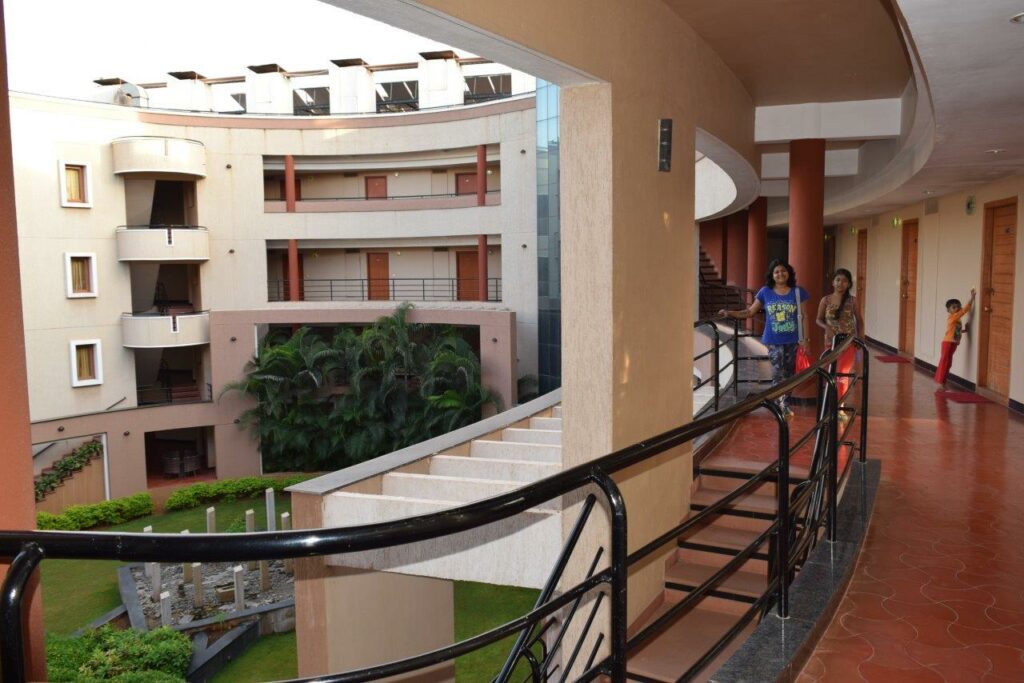
Evening was spent in strolling through the nearby local market of Hosapete.
Day 2: Explore Hampi and Drive to Bangalore (342 km, 6.5 hrs)
Day 2 was scheduled for exploring Hampi. After having a sumptuous breakfast from a full spread of buffet breakfast, we left for Hampi, which was 10 km away and can be reached by 20 minutes of drive. Most of the temples can be visited from 6 AM till 6 PM and takes an average 30-45 minutes to explore each one of them. We parked our car in a parking lot close to Sasivekalu Ganesha and then walked to explore the first 3 attractions.
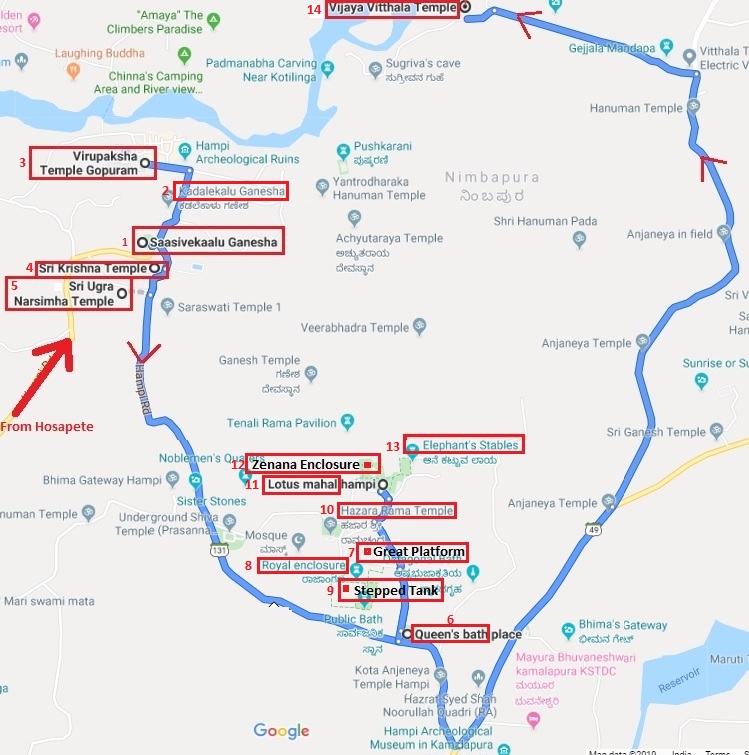
Sasivekalu Ganesha:
Huge statue of Lord Ganesha, carved out of a single block of rock. It is one of the major landmarks and is about 8 feet tall. According to the Hindu mythology, Lord Ganesha is known for his love for food. Once Ganesha consumed a lot of food, due to which his stomach was on the verge of bursting. Finding no other option to stop his stomach from exploding, Ganesha caught hold of a snake and tied it around his stomach in order to prevent it from bursting open. This is the mythological incidence behind the existence of the snake tied around the Ganesha’s stomach, which is visible on the statue.
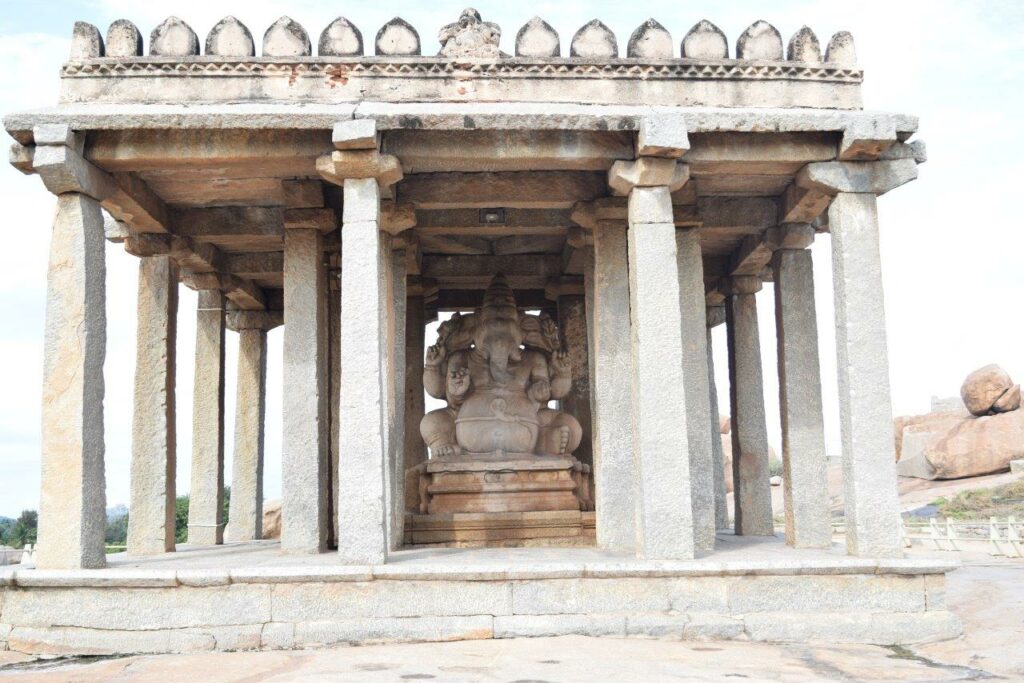
Kadalekalu Ganesha:
This temple is walking distance from Sasivekalu Ganesha and close to Virupaksha. Carved from a single granite bolter, the belly of Ganesha in this temple has been chiselled in such a manner that it resembles a Bengal gram (‘Kala chana’ in Hindi and ‘Kadalekalu’ in Kannada), hence, the statue has been given the name of Kadalekalu Ganesha. The temple is decorated with tall and slender granite pillars which have various mythological characters carved on them.
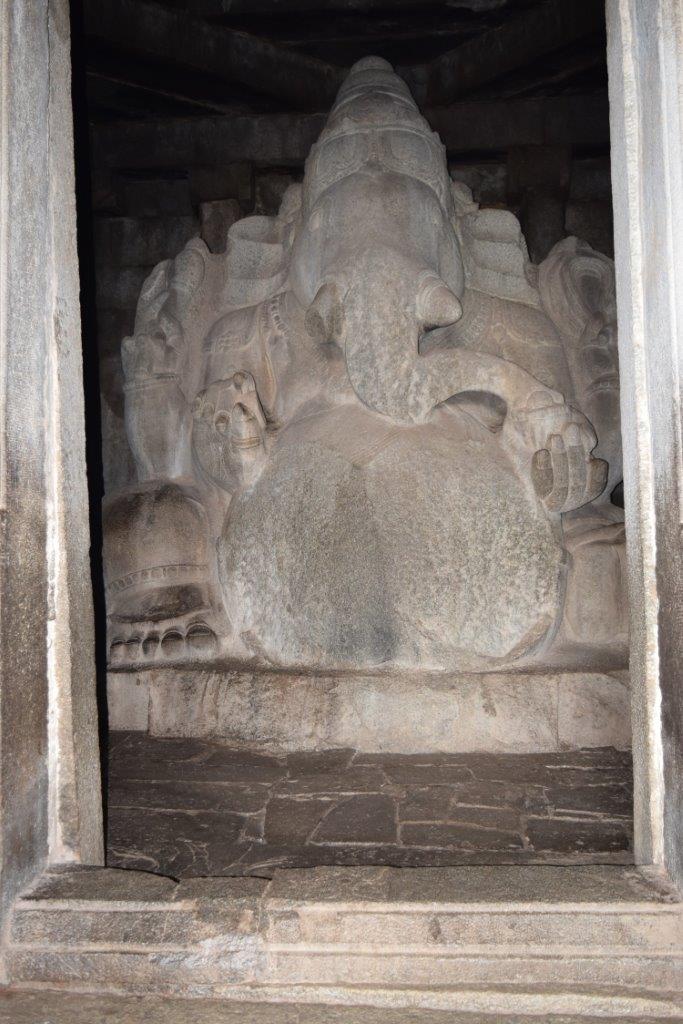
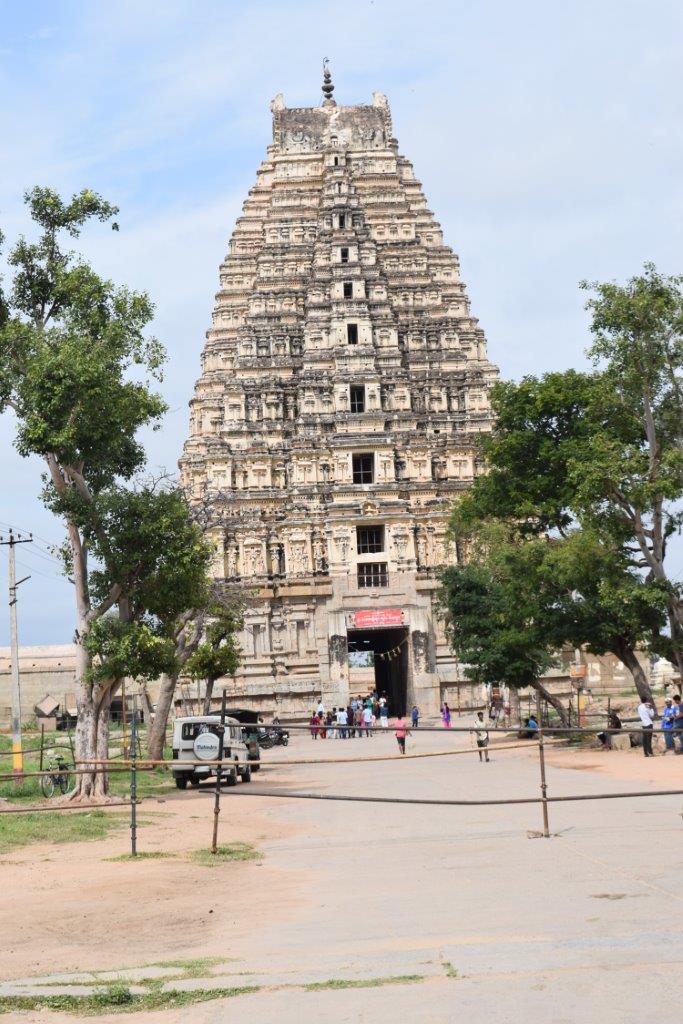
Virupaksha Temple
The Virupaksha Temple is dedicated to lord Shiva and is worshiped even today. It was developed into a huge complex during the Vijayanagara rule. The temple has a huge gateway in the east which is nine-tiered and 50 meters in length.
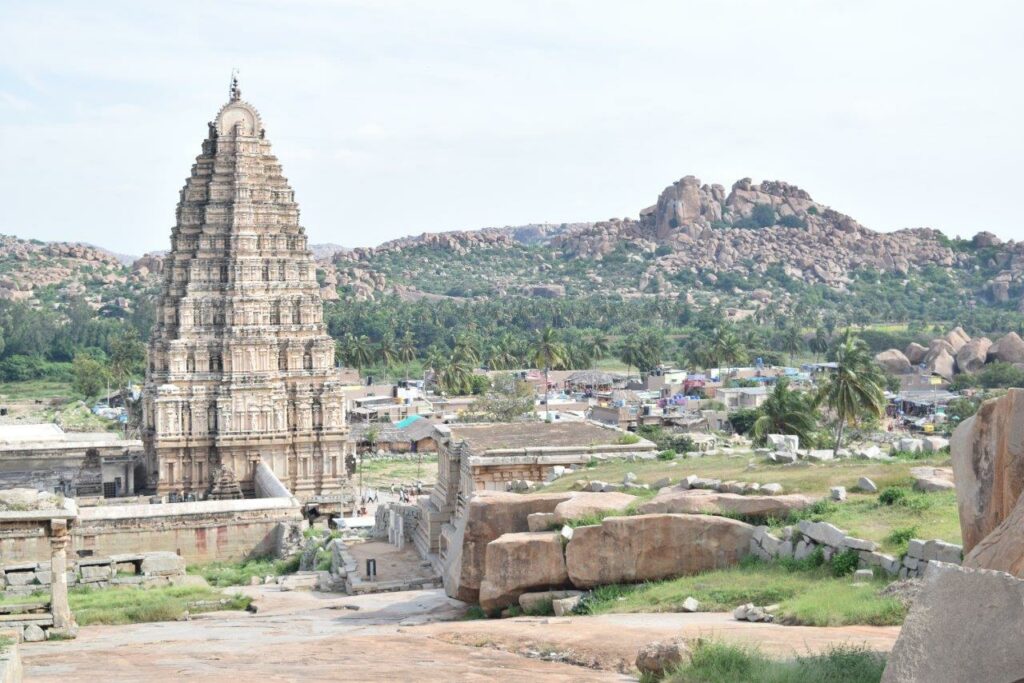
In front of the Virupaksha temple was a kilometer long Hampi Bazaar which ends at the foothill of Matanga Hill. Both sides of the street have a series of very old pavilions, some single storied and others two storied. These buildings were once the part of a booming market and houses of the upper class merchants. It is from here, merchants used to sell precious stones, jewelry, silk clothes, cows, horses etc. during Vijayanagara rule.
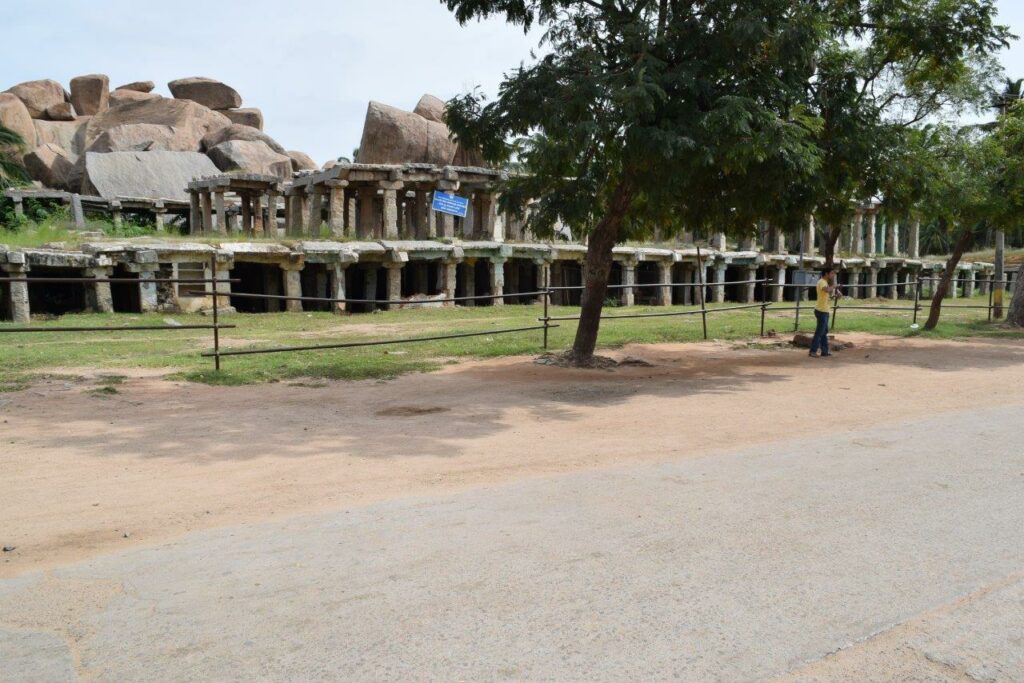
Sri Krishna Temple
After visiting the Virupaksha temple, we drove towards the Sri Krishna Temple. The temple was built by Krishnadevaraya of Vijayanagara Empire in 1513 AD, to commemorate his victory over Prataparudra Gajapati, the ruler of the eastern kingdom of Udayagiri (Orissa)
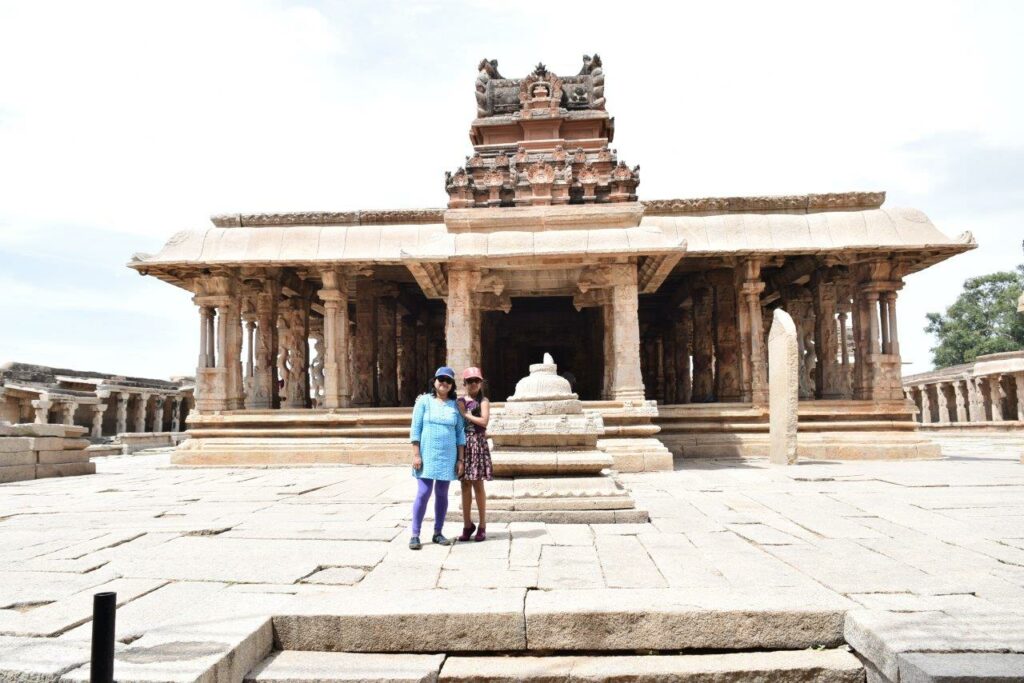
The temple has two enclosures. Built in the center of complex, there is a main shrine and many sub shrines. The pillars and the entrances to the temple hall are engraved and adorned with numerous carvings of warriors with shields, horses and elephants. One can also find the epic stories from Hindu mythology carved on the walls of this temple.
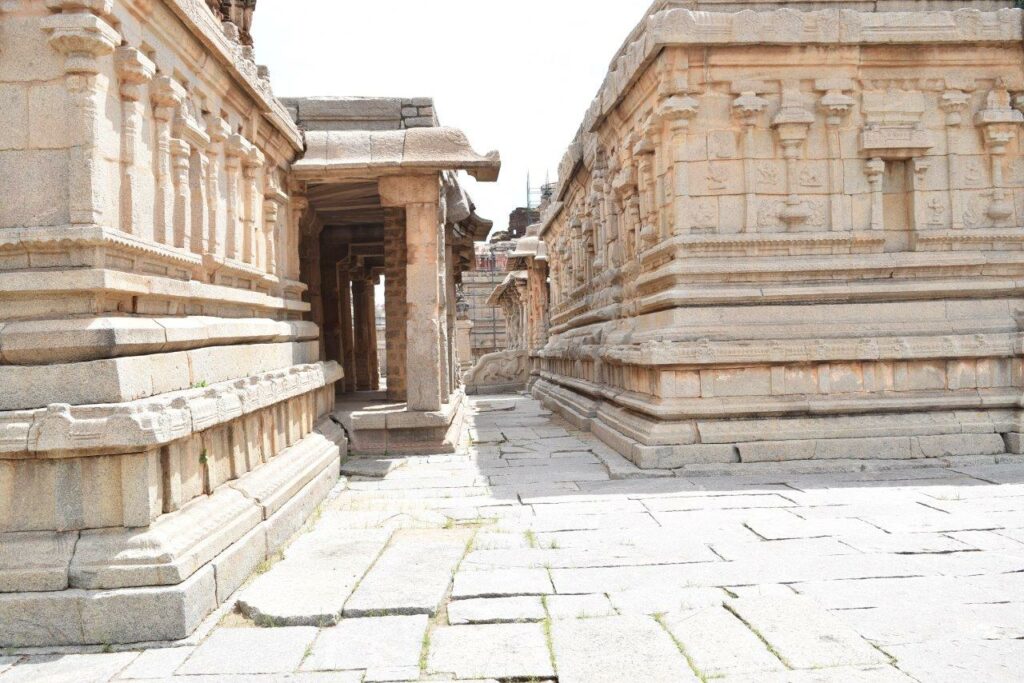
Sri Ugra Narsimha Temple
A few meters further to Sri Krishna Temple is the largest monolith (built from single block of stone) statue of Lord Narasimha in sitting position on the coil of a giant seven-headed snake.
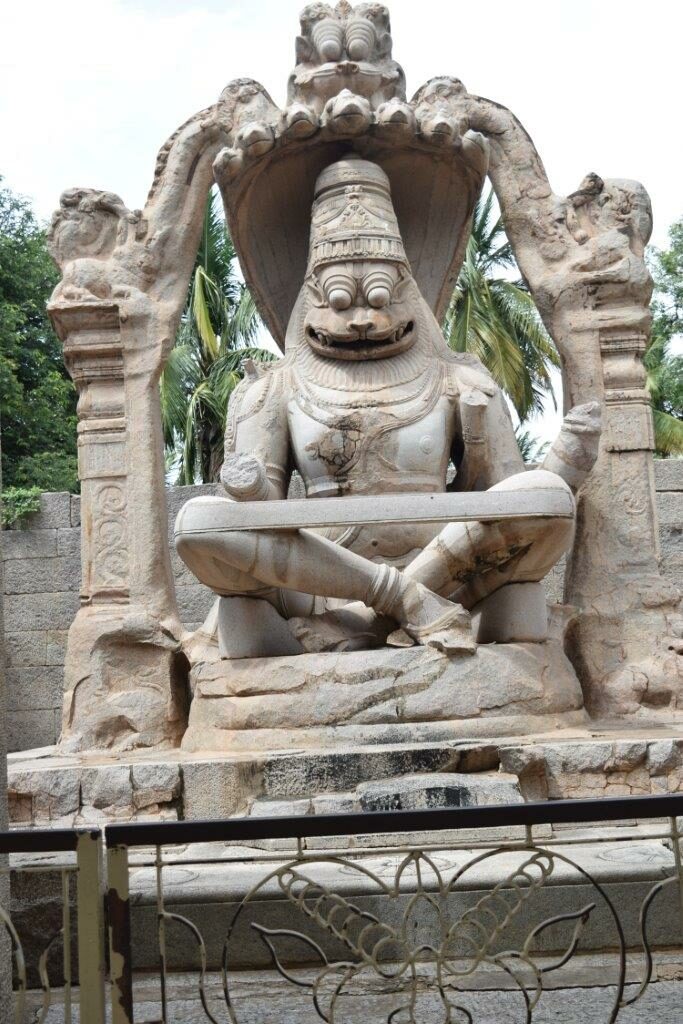
The protruding eyes and the facial expression are the basis for this name (‘Ugra’ is Hindi word of Angry). The heads of the snake act as the hood above his head. The idol sits in a cross-legged yoga position with the belt supporting the knees. It was carved in 1528 AD during the rule of Krishnadevaraya. The original statue contained the image of goddess Lakshmi, sitting on his lap. But due to the destruction by invading armies, one of the hands of Goddess Lakshmi was broken and the remains can still be seen resting on the back of Narasimha. The damaged statue of Lakshmi resides in the Archaeological Museum at Kamalapura.
Queen’s Bath :
It was probably a royal complex for the king and his wives. The architecture of this complex is in a bit more Islamic style. It is rectangular building with a big open pond at the middle. The pond is surrounded by many balconies which are decorated with tiny windows. It is believed that once fragrant flowers and perfumed water filled this bathing pool. The whole building from inside looks like some ancient indoor aquatic complex. There is a small garden in front for the queen’s bath which is a favorite spot for picnics.
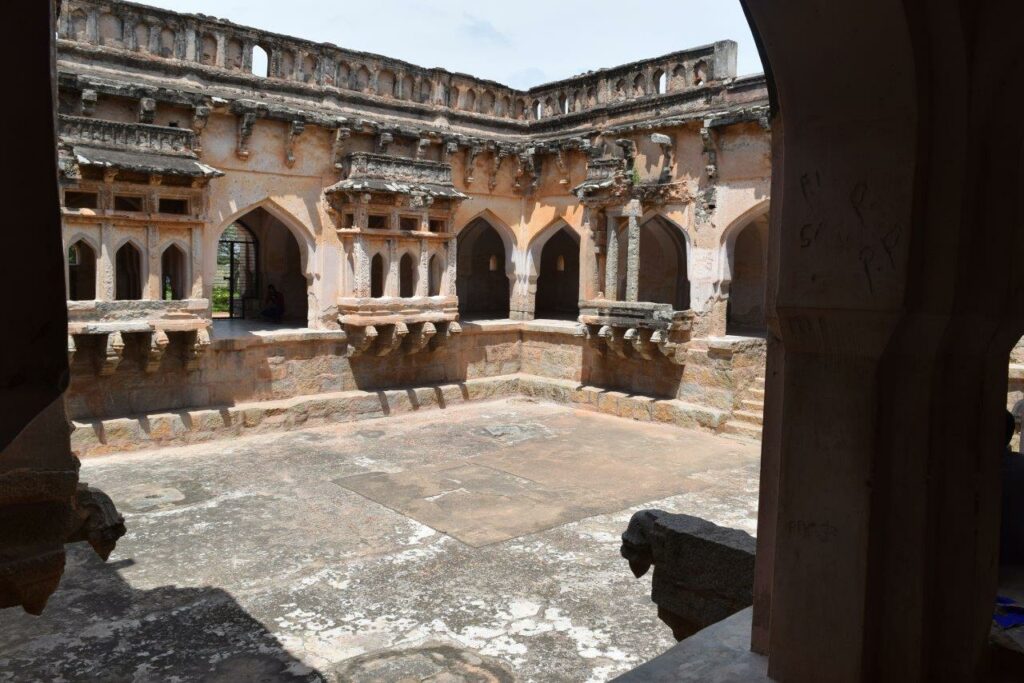
Royal Enclosure and Mahanavami Dibba
A bit further to Queens bath is the Royal Enclosure. It is a huge fortified area that was once the heart of the Vijayanagara Empire. This was the place where the royal family of the Vijayanagara Empire used to reside and the ‘durbar’ used to be performed. Spread over a huge area, it is believed to have once housed over 45 buildings, all used by the royal family. The most impressive structure in the Royal Enclosure is the Mahanavami Dibba or the Dasara Dibba which is also known as the House of Victory.
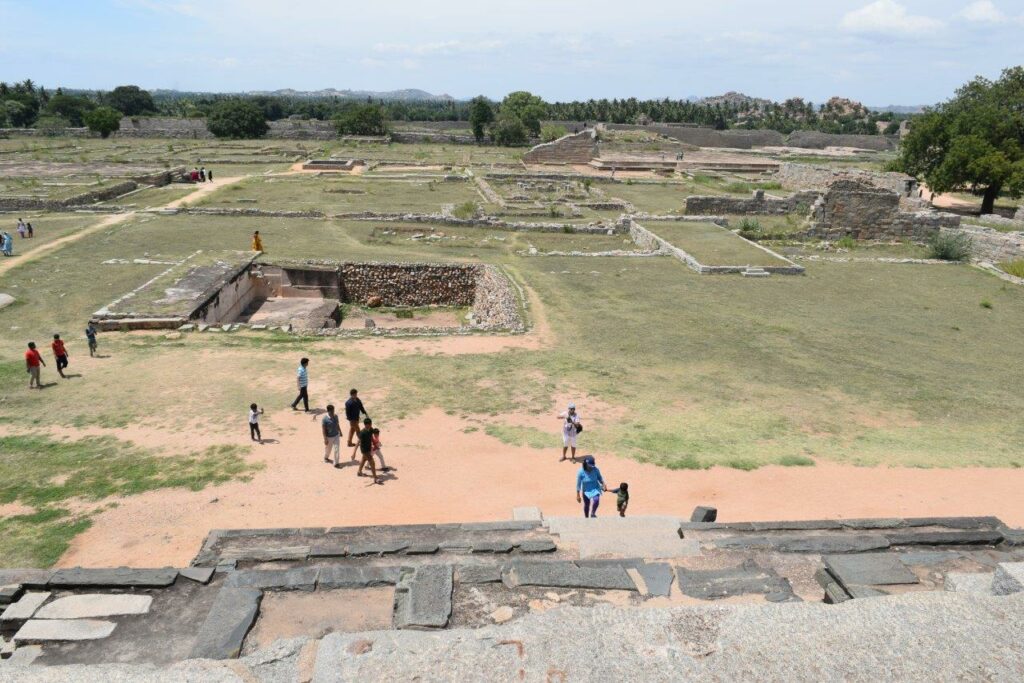
Mahanavami Dibba is a beautiful stone platform situated inside the Royal Enclosure. It was built by King Krishnadevaraya after his conquest over the kingdom of Udayagiri (present day Odissa). The grand platform was used by the kings to watch the army march-past, war games and the royal procession that were held during the Mahanavami festival, also known as the Dasahara festival, hence the name Mahanavami Dibba. The top of the platform provides a splendid view of the surrounding areas.
Stepped Tank
The Stepped tank is located close to Mahanavami Dibba in Royal enclosure and was excavated by Archeological Survey of India. It has been constructed using blocks of black stones. This Tank was probably used by the royals for religious purpose. It has five distinct tiers, each fitted with steps set in a beautiful pattern. The marks on the tank and individual blocks indicate the direction of flow of water. The water to this tank was drawn through the intelligently designed stone channels which are well preserved till date.
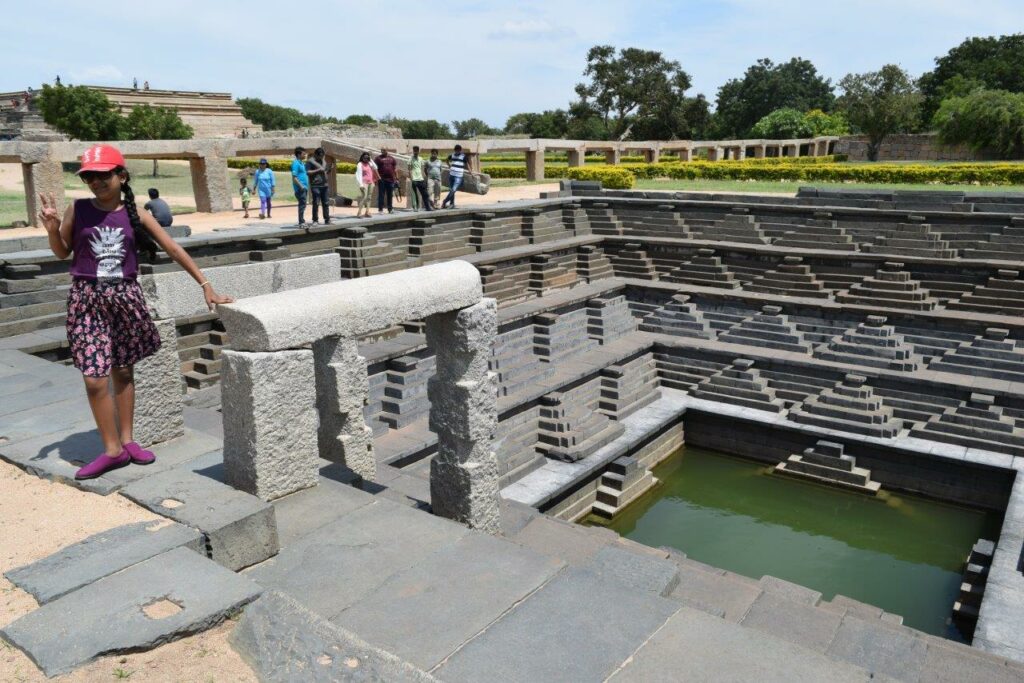
Hazara Rama Temple
Hazara Rama means a thousand Rama and refers to the large number of events from Ramayana depicted on the walls. This temple is believed to be the private temple of the kings and the royal family of Vijayanagara. The temple has a well carved compound wall and the exterior walls have been decorated with carvings which narrate the entire story of Ramayana. This temple further leads to Zenana Enclosure
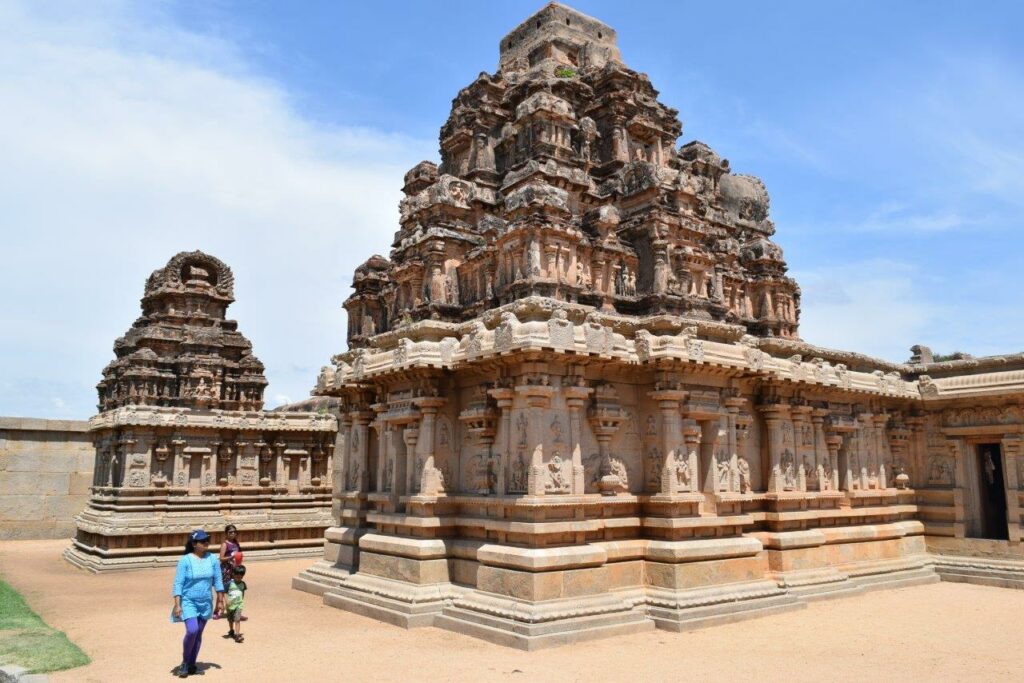
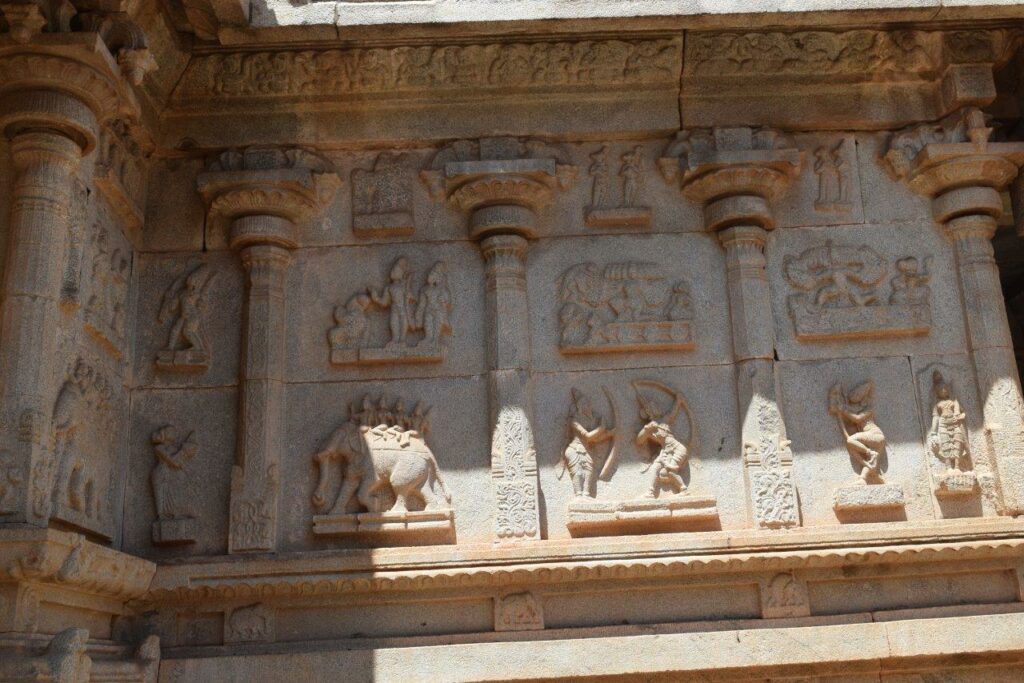
Zenana Enclosure
It was a fortified and secluded area for the royal ladies of the Vijayanagara Empire. The enclosure was surrounded by tall walls and four watch towers, out of which only 3 remain now. A distinctive feature about the Zenana Enclosure is that it was a well-guarded place during the days of the Vijayanagara Empire.
It is believed that the watch towers and the whole enclosure were guarded by the eunuchs. These eunuchs prevented any male (the king being an exception) from entering the area. The structures of the enclosure are designed in the Indo-Islamic style of architecture.
However, there is another school of archaeologists who believe that due to proximity of the nearby structures (the elephant stables, the guards quarters etc), the enclosure was never used as the women’s area. They believe that the Lotus Mahal was a council room for the chief commanders, the towers at the corners was the armory or treasury rather than the quarters for the eunuch guards and the palace belonged to the king.
Zenana Enclosure includes several structures such as the Lotus Mahal, basement of the Queen’s Palace and Elephant Stables. There is an entry fee (₹ 10 in 2016) which covers all the attractions within the enclosure.
Basement of Queen’s Palace
The Queen’s Palace is a ruined structure that has only the basement as a proof of its existence. The basement is located in the center of the Zenana Enclosure. The elaborate base suggests that the original palace might have been a grand structure which was probably made of wood. There is a deep rectangular water tank near the basement which was probably used as a source of water for the palace.
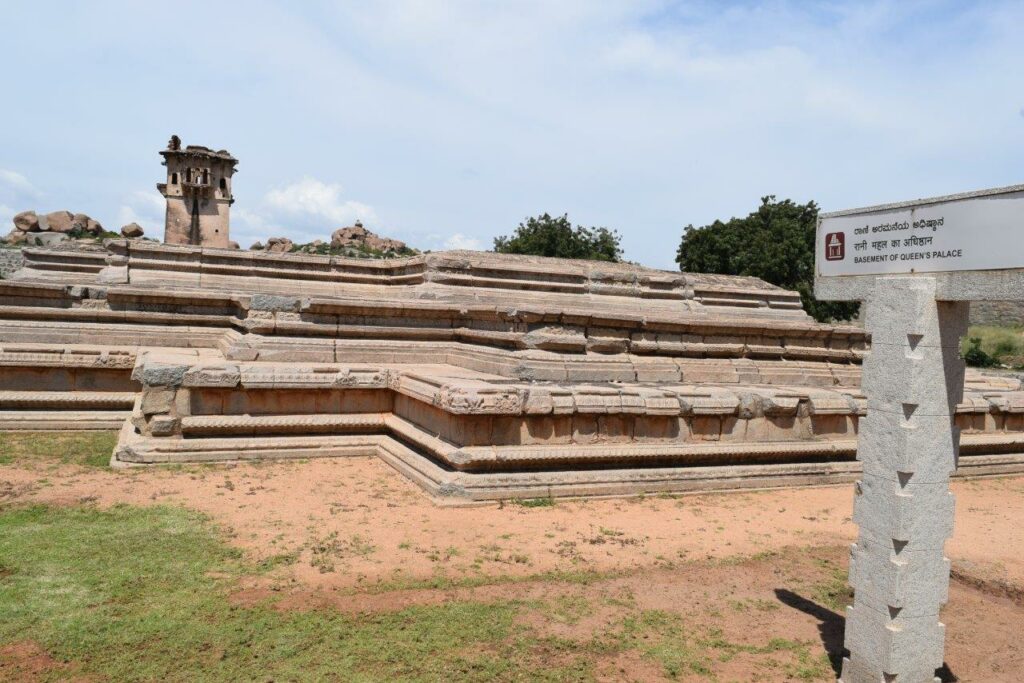
Lotus Mahal :
Lotus Mahal is the primary attraction of the Zenana Enclosure. It resembles petals of a lotus and provide the whole structure the shape of a half-open lotus. Built in Indo-Islamic style, the base of the structure resembles Hindu temple style while the upper superstructure is Islamic in architecture with pyramidal towers.
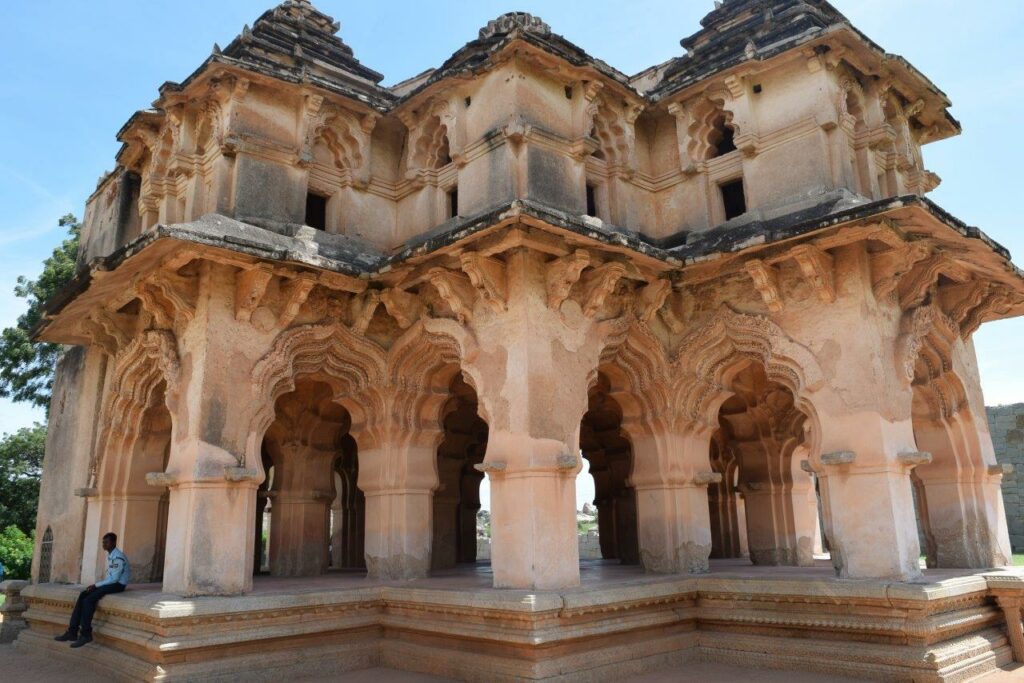
Elephant’s Stables
The Elephant Stable were used to provide shelter for the royal elephants of the Vijayanagara Empire. It is one of the very few structures which have not suffered the damage during Deccan Sultanate attack on Hampi. Built in Indo-Islamic architecture, there are 11 domed tall chambers with metal hooks on the inside roof. The elephants were tied to these hooks from the center of the ceiling. At the rear of each hall are small openings for the ‘mahouts’ (elephant keeper/rider) to enter the elephant compartments. The open area in front of the building was a parade ground for the elephants.
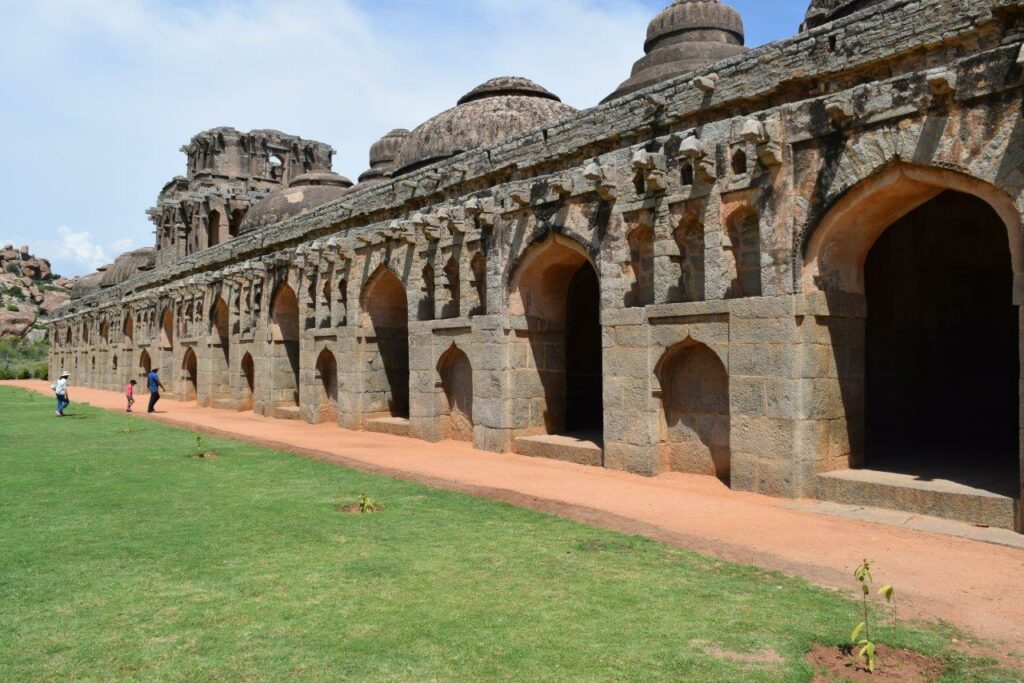
It was noon by the time we finished exploring Zenana Enclosure. From there we drove to the last and the most famous monument of Hampi – Vittala Temple. The temple is about 6 km drive from Zanana Enclosure.
Vitthala Temple
This monument is located on the southern bank of the Tungabhadra River. It is one of the largest and the most famous structures in Hampi.
The movement of vehicles is banned on the 1.3 km stretch between the car parking and the temple complex as a precautionary measure to protect the monument from pollution. For the convenience of the tourists, the authorities have introduced battery operated vehicles to ferry the tourists at a nominal charge of ₹ 20 for to-and-fro journey. This temple is dedicated to Lord Vishnu in the form of Vittala. This monument is a major attraction of Hampi and is a must see. The temple is built in Dravidian style and stands in a large rectangular enclosure which houses several temples.
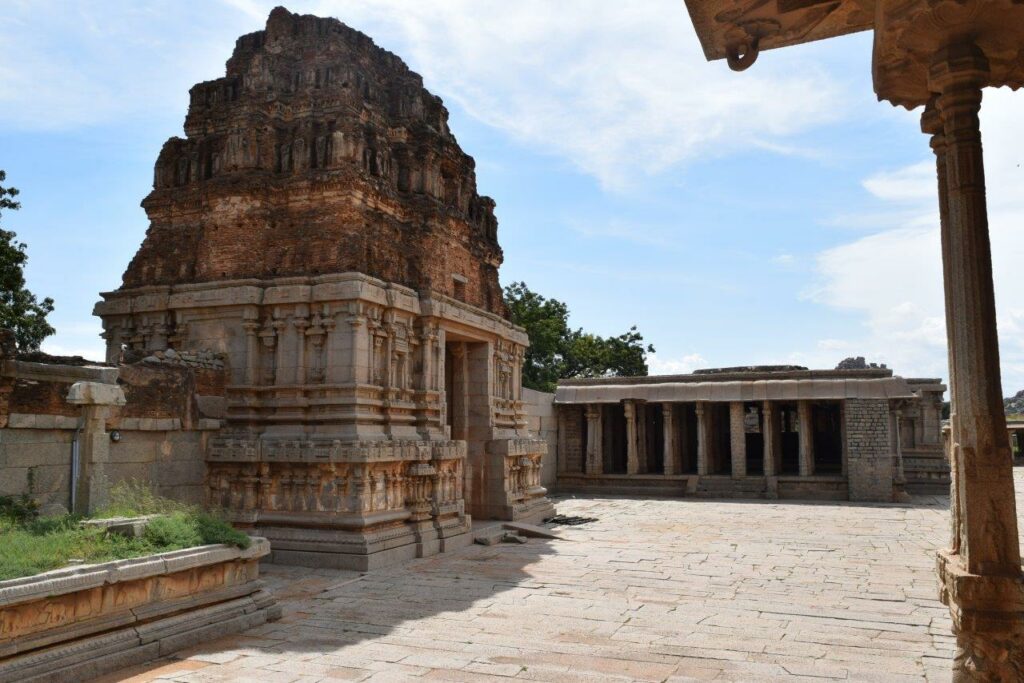
In front of the temple is the world famous Stone Chariot. This is one of the three famous stone chariots in India, the other two being in Konark (Orissa) and Mahabalipuram (Tamil Nadu). The chariot, built on a rectangular platform has been carved out of giant granite block. The base of chariot is chiseled with mythical battle scenes.
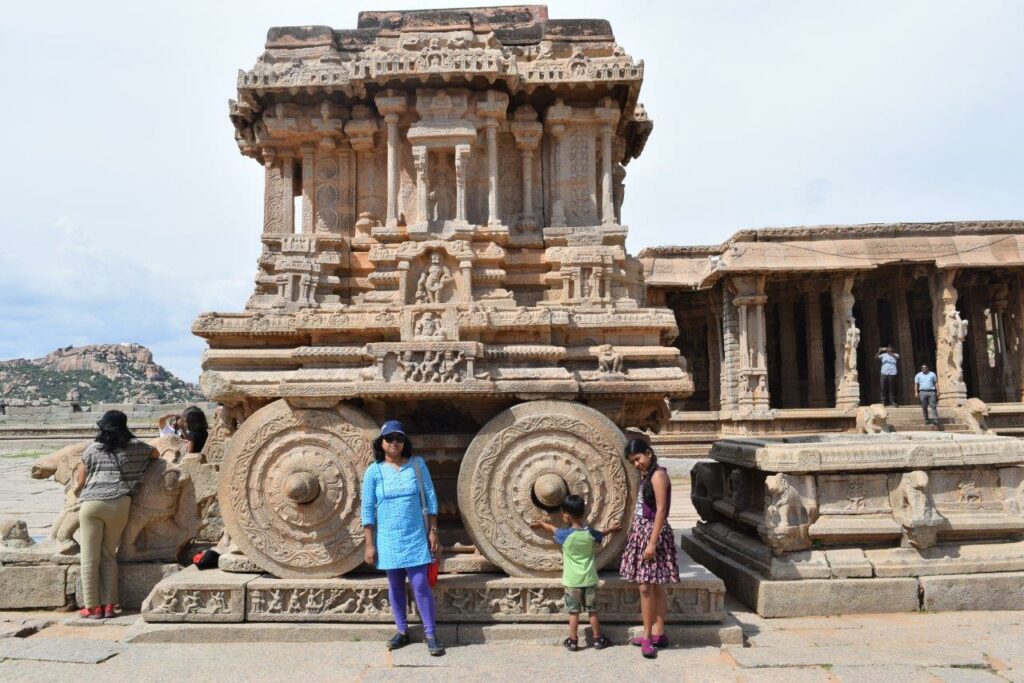
The complex contains four large mandapas, out of which 3 still remain. The main mandapa has a set of main and minor pillars. The main pillars are designed as musical instruments. Every main pillar is surrounded by several minor pillars that emit different sounds of the instrument.
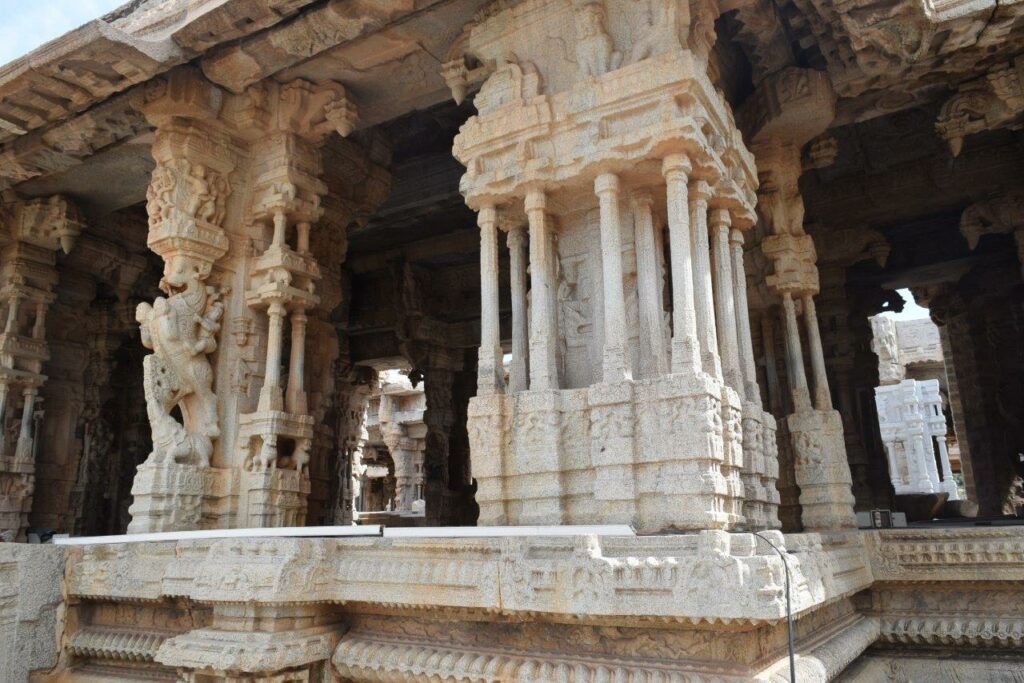
By the time we finished exploring the Vitthala Temple it was 3 pm. The plan was to travel to Bangalore on the same day which was 350 km and going to take 6/7 hours. Anticipating delay in reaching Bangalore, we drove back to our hotel and after a quick lunch we checked out were soon driving our way to Bangalore.
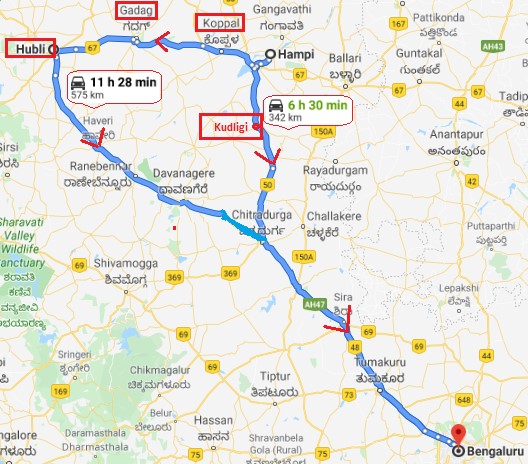
Bangalore can be reached from Hampi via below 2 routes:
- NH-50 via Kuldigi – Chitradurga – Bangalore. This route is 342 km and takes 6:30 hrs.
- NH-48 via Koppal- Gadang – Hubli – Chitradurga – Bangalore. This route is 575 km and takes 11:30 hrs
Since the first option was about 230 km shorter, we opted for it. Unfortunately, this route turned out to be single lane with heavy truck movement. Though road widening was ongoing during Oct 2016, I will advise to check the road status before opting for it. After 3.5 hours of drive, when we reached Chitradurga it was 7:30 pm. From Chitradurga we joined the 6 lane Pune-Bangalore Expressway, which was a smooth drive from there till Bangalore.
However; since I am not comfortable driving during night, I kept the car’s speedometer within the range of 80-85 km/hr. By the time we reached our relatives at Bangalore (Kaggadasapura), it was 11 pm. We quickly had dinner and slipped into our beds. It had indeed been a long and a memorable day.
Day 3: Relax at Bangalore and visit the Bannerghatta National Park
During our past visit to Bangalore (https://travel-memoirs.com/road-trip-to-south-karnataka/ ), we had covered most of the attractions of the city but unfortunately left out Bannerghatta National Park as it’s a bit out of the city.
On our second visit to the City, we decided to pay a visit to this left over attraction. After a hefty breakfast, we left for the park which is about 30 km south to Kaggadasapura. Being a weekend, it took us 1 hr & 45 min to reach the park.
Bannerghatta national park is one of the famous tourist places in Bangalore. The park comprises of various attractions like – Zoo, Wildlife Safari, Butterfly Park, snake house and aquarium. The zoo showcases a variety of mammals, reptiles and birds. The Butterfly Park consists of around 48 different species of butterflies are conserved in the park.
Probably the most unique attraction of the park is the Safari conducted by KSTDC. The enclosed safari vehicle carries the tourists to the center of the forest to watch the animals like – Lions, Tigers and Bears living in a natural habitat closely.
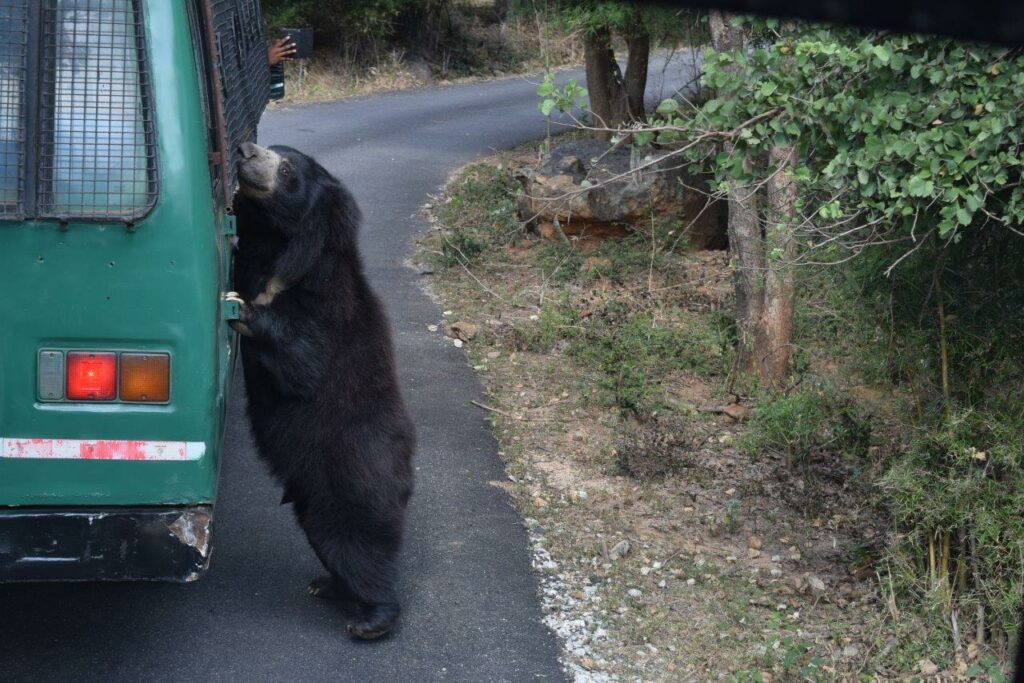
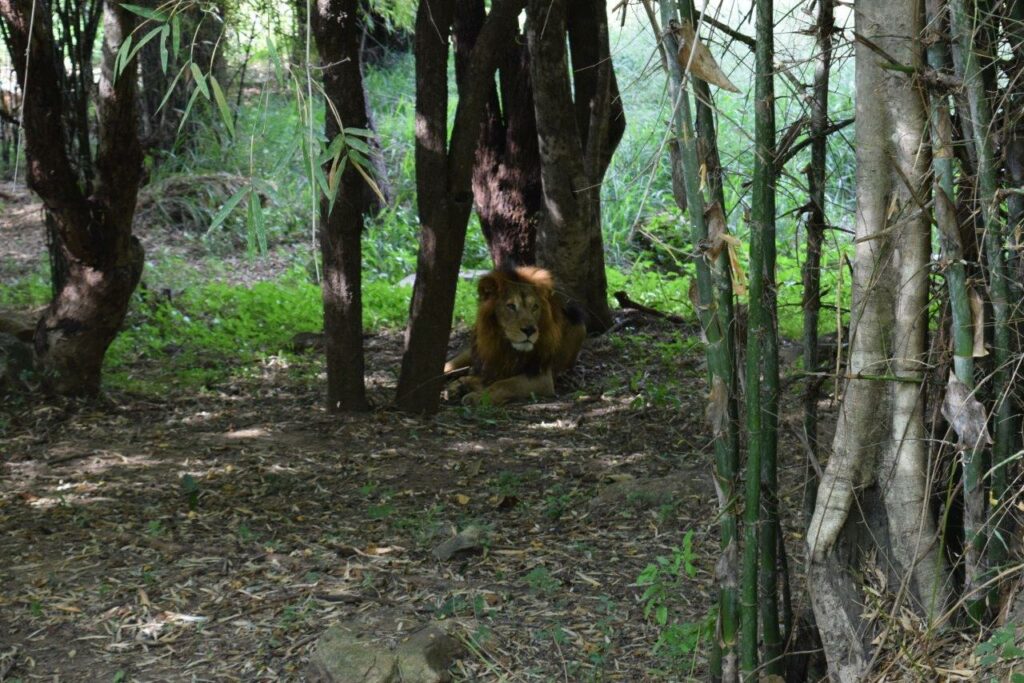
The route to the safari passes through hills and valleys along with green and dark forest. I did not come across any parks in India which provides a safari though enclosed area and gives you an opportunity to see animals so closely. So if you are in Bangalore, forest safari at Bannerghatta is strongly recommended. Detailed information on entry fee and timings can be found on http://bannerghattabiologicalpark.org/
Day 4: Drive from Bangalore to Pune (850 km, 14 hrs)
Last day of the trip was for driving back home to Pune. A distance of 850 km was to be covered in a day which is probably the longest drive done in a day till date by us. We do not prefer travelling more than 500-600 km in a day and have always split the Pune-Bangalore drive in two days (Goa being a preferred break spot). but keeping in view the excellent road conditions for the Pune-Bangalore Expressway (NH-48), we decided to take an exception and give it a try. We left Bangalore early morning at 6 am without having breakfast to escape early morning city traffic.
The drive till Pune took us 14 hours, which involved breaks for breakfast, lunch and evening tea. Tough 14/15 hours of drive is hectic and tiresome, it is manageable on this expressway due to excellent road conditions. The only bad sections and traffic jams you get is after entering Maharashtra because of the diversions due to never ending flyover construction work after Kapurhol.
Great content! Super high-quality! Keep it up! 🙂
Thanks for kind words.
Fantastic Webpage, Maintain the good job. Thanks for your time.
I know this if off topic but I’m looking into starting my own weblog and was curious what all is
required to get setup? I’m assuming having a blog like yours would cost a pretty penny?
I’m not very internet smart so I’m not 100% sure.
Any tips or advice would be greatly appreciated.
Thank you
Comments are closed.